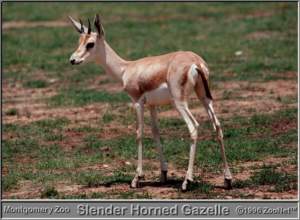Gazelle

|
A small or medium-sized long-legged antelope of
the genus Gazella. Gazelles are found in regions of Asia and
Africa between 52 degrees N and 6 degrees S, roughly from
Mongolia to central Tanzania. They live in open, dry country
and are the characteristic antelope of this habitat.
Zoologists have found it hard to differentiate
between species. In eastern Asia the Mongolian gazelle and
allied species are adapted to cold winters. The Persian gazelle
lives in drier country,ranging as far as the hot deserts of
Arabia. The most widespread species, or species group, is
represented by Bennett's gazelle of India, the one or more Arabian gazelles, and the North African dorcas
gazelle. Thomson's gazelle and the Korin gazelle are two African species rather larger than the dorcas
gazelle and found in less harsh habitats. Other African species are the slender-horned gazelle, Cuvier's
gazelle and Speke's gazelle. An African group of large gazelles comprises the dama gazelle, Soemmerring's
gazelle and Grant's gazelle.
The dama gazelle is the biggist species, with a shoulder height of about 40 inches (100 cm),
as compared with 24 inches (60 cm) in the dorcas gazelle. Body weights of adults are from 44 to 165
pounds (20 to 75 kg). The longest known horns, those of a male Grant's gazelle, measure 32 inches(80
cm). In an adult male dorcas gazelle the normal length is about 10 to 12 inches ( 25-30 cm). Most
species are colored reddish fawn, with a white belly and often a dark band on the flanks. They have a
facial pattern of dark and light stripes, and the females usually have horns.
Some species are mainly grazers. The Thomson's gazelle of Kenya and northern Tanzania, for
example, follows the zebra and wildebeest in a grazing succession. Other species, especially in drier
areas, eat less grass. Many go for long periods without drinking. They meet their water needs from dew
or whatever green leaves. seasonal migration are known in nearly all species and are linked with
availability of food.
Gazelles have long legs and can run very fast. Occasionally they used a stiff-legged gait called
"stotting." They were the main prey of the cheetah, which has now been destroyed in much of its range.
The wolf preys on Asiatic gazelles. Other predators, such as hyenas, are at least locally important. Jackals
take some of the newborn. Among antelopes, gazelle have been the last to disappear from many areas,
and some species may still be locally common. However, there seems little chance for their ultimate
survival outside zoos and game reserves.
Sizes of herds vary. The Mongolian gazelle and Sommerring's gazelle may go in herds of some
hundreds, whereas Grant's gazelle and the Persian gazelle travel in smaller groups. Single adult males
defend territories with breeding females, while younger males associate in bachelor herds. During
courtship the male Thomson's gazelle follows the female, raising and lowering his neck, and then taps
the female's hind leg with his foreleg to ascertain whether she is ready to mate. Similar behavior probably
occurs in all species.
Females breed during their first year and give birth to a single young after a gestation period
of 3 to 5 months. Gazelles may live to 12 or 15 years.
Sand Gazelle
 Back to main page
Back to main page

